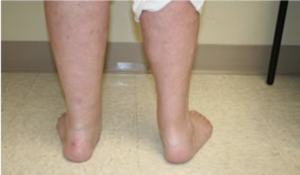COMMON CONDITIONS
Posterior Tibial Tendonitis Disorder | What is Posterior Tibial Tendonitis? Causes, Symptoms and Treatment IN RICHARDSON, DALLAS, GARLAND, WYLIE, MURPHY.
What is Posterior Tibial Tendonitis Disorders (Fallen Arches)?
The posterior tibial tendon is the strongest tendon supporting your foot. Posterior tibial tendonitis disorder (PTTD) is a condition brought about by changes in the tendon, reducing its ability to support the foot. As a result, the foot becomes flat.

PTTD is regularly called adult acquired flat foot. Although this condition regularly happens in just one foot, it can occur in both.
Posterior tibial tendonitis which is the precursor to tendon dysfunction is caused by many factors. Some of the important factors are as under:
- Overuse of the posterior tibial tendon may cause the disorder.
- Improper shoe gear
- Activities like running, walking and climbing can also cause the disorder.
Posterior tibial tendonitis Symptoms:
The disorder has many symptoms. Posterior tibial tendonitis symptoms may be as under:
Initially, pain, swelling, a flattening of the foot may be felt initially along with an inward rolling of the ankle. This pain may be on inner side of the foot and later on it may produce redness and swelling.
Afterward, the foot flattens and toes start to turn outward and the lower leg rolls internal.
As the tendon deteriorates, arthritis often develops in the foot. In more severe cases, arthritis may also develop in the ankle.
Treatment for the posterior tibial tendonitis:
It is imperative to know as how to treat posterior tibial tendonitis. As the PTTD is progressive in its nature, it is imperative that you consult a physician and take proper treatment. Otherwise the issue could get worse at later stages.
Initially, PTTD treatment can start with non-surgical approach which is as under:
- Orthotic devices or bracing. In order to support your foot and ankle, you need to put on the brace. The brace need to fit in the shoes for proper results.
- Immobilization. In order to keep the foot at rest, the immobilizer is used. The resting of the foot and avoiding more weight is also important.
- Physical Therapy: Posterior tibial tendonitis physical therapy exercises also prove to be healing factor for the disorder. .
- Icing: Icing is also done to give some relief from the pain. The ice is applied for the 20 minutes in 3 to 4 time in day for 20 minutes on most affected area of foot.
- Medications. Non-steroidal anti-inflammatory drugs (NSAIDs) can be used to reduce the inflammation. These drugs involve ibuprofen and other such categories. An injection like cortisone
- Shoe Modification: Proper shoe gear and inserts can prevent the progression of the condition.We will help you in this regard.
When Is Surgery Needed?
Sometime, the disorder of posterior tibial tendon does not improve. So you have no choice than to go for a surgery. The disorder can be fixed with surgery.
Different forms of surgeries include:
- Lengthening of Achilles Tendon
- Cleaning the tendon
- Tendon transfer – replacement of the tendon
- Bone grafting
- Re-alignment of foot
Overall, posterior tibial tendonitis disorder can be treated with non-surgical methods if diagnosed early. However, if the issue persists and goes undetected then surgical correction may be required.
If you suspect that you have this condition, call us before the condition worsens.
Posterior Tibial Tendonitis Disorder | What is Posterior Tibial Tendonitis? Causes, Symptoms and Treatment IN RICHARDSON, DALLAS, GARLAND, WYLIE, MURPHY.
Dr. Raymond Delpak works with patients to determine the best course of action for treating foot and ankle problems. We use the most advanced techniques possible. If you would like to learn more, please visit us TX Foot and Ankle Consultants or schedule an appointment.
SUBSCRIBE TO OUR NEWSLETTER
*for updates on our medical equipment only

